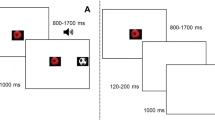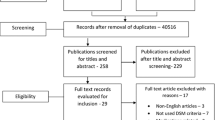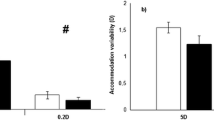Abstract
Earlier studies have suggested an impairment in the attention and eye movement control of children with ADHD. An important phenomenon in the control of attentional shifts and eye movements is the inhibition of return (IOR), which states that our brain works in a way that prevents our attention from returning to a spatial location that has been attended to, either overtly or covertly. This current study addresses whether the IOR in oculomotor planning is compromised in children with ADHD. Eleven ADHD and 12 age- and gender-matched control subjects participated in a behavioral task, in which they made saccades to a peripheral target after a valid, invalid or neutral cue. The latency difference between cued and uncued saccades over a range of cue-target onset asynchrony as well as the positive component of this latency profile (i.e., IOR) was compared between groups. The results show that ADHD children demonstrate a biphasic latency profile that is grossly similar to that observed in control subjects, although the magnitude of IOR appears to be slightly smaller in ADHD subjects. These preliminary results suggest that the inhibitory attention mechanism subserving IOR is at least not fully compromised in ADHD children.


Similar content being viewed by others
References
Achenbach TM (1991) Manual for the child behavior checklist/4–18 and 1991 profile. Department of Psychiatry, University of Vermont, Burlington, VT
Barkley RA (1997) Behavioral inhibition, sustained attention, and executive functions; constructing a unifying theory of ADHD. Psychol Bull 121:65–94
Blondis TA, Snow JH, Accardo PJ (1999) Methods of measuring attention deficits with or without hyperactivity-impulsivity. In: Accardo PJ, Blondis TA, Whitman BY, Stein MA (eds) Attention deficits and hyperactivity in children and adults. Marcel Dekker, New York, pp 163–187
Briand KA, Larrison AL, Sereno AB (2000) Inhibition of return in saccade and manual response systems. Percept Psychophys 62:1512–1524
Carter CS, Krener P, Chaderjian M, Northcutt C, Wolfe V (1995) Asymmetrical visual-spatial attentional performance in ADHD: evidence for a right hemispheric deficit. Biol Psychiatry 37:789–797
Castellanos FX, Marvasti FF, Ducharme JL, Walter JM, Israel ME, Krain A, Pavlovsky C, Hommer DW (2000) Executive function oculomotor tasks in girls with ADHD. J Am Acad Child Adolesc Psychiatry 39:644–650
Chambers WJ, Puig-Antich J (1985) The assessment of affective disorders in children and adolescents by semistructured interview: test–retest reliability of the Schedule for Affective Disorders and Schizophrenia for school age children, present episode version. Arch Gen Psychiatry 42:696–702
Corkum PV, Siegel LS (1993) Is the continuous performance task a valuable research tool for use with children with attention-deficit-hyperactivity disorder? J Child Psychol Psychiatry 34:1217–1239
Epstein JN, Conners CK, Erhardt D, March JS, Swanson JM (1997) Asymmetrical hemispheric control of visual-spatial attention in adults with attention deficit hyperactivity disorder. Neuropsychology 11:467–473
Gould TD, Bastain TM, Israel ME, Hommer DW, Castellanos FX (2001) Altered performance on an ocular fixation task in attention-deficit/hyperactivity disorder. Biol Psychiatry 50:633–635
Houghton S, Douglas G, West J, Whiting K, Wall M, Langsford S, Powell L, Carroll A (1999) Differential patterns of executive function in children with attention-deficit hyperactivity disorder according to gender and subtype. J Child Neurol 14:801–805
Klein RM (1988) Inhibitory tagging system facilitates visual search. Nature 334:430–431
Klorman R, Hazel-Fernandez LA, Shaywitz SE, Fletcher JM, Marchione KE, Holahan JM, Stuebing KK, Shaywitz BA (1999) Executive functioning deficits in attention-deficit/hyperactivity disorder are independent of oppositional defiant or reading disorder. J Am Acad Child Adolesc Psychiatry 38:1148–1155
Kustov AA, Robinson DL (1996) Shared neural control of attentional shifts and eye movements. Nature 384:74–77
Lepsien J, Pollmann S (2002) Covert reorienting and inhibition of return: an event-related fMRI study. J Cognit Neurosci 14:127–144
Li C-SR, Lin SC (2002) A perceptual level mechanism of inhibition of return in oculomotor planning. Cogn Brain Res 14:269–276
Losier BJ, McGrath PJ, Klein RM (1996) Error patterns on the continuous performance test in non-medicated and medicated samples of children with and without ADHD: a meta-analytic review. J Child Psychol Psychiatry 37:971–987
McDonald S, Bennett KMB, Chambers H, Castiello U (1999) Covert orienting and focusing of attention in children with attention deficit hyperactivity disorder. Neuropsychologia 37:345–356
Moore T, Fallah M (2001) Control of eye movements and spatial attention. Proc Natl Acad Sci U S A 98:1273–1276
Mostofsky SH, Lasker AG, Cutting LE, Denckla MB, Zee DS (2001) Oculomotor abnormalities in attention deficit hyperactivity disorder: a preliminary study. Neurology 57:423–430
Nigg JT, Swanson JM, Hinshaw SP (1997) Covert visual spatial attention in boys with attention deficit hyperactivity disorder: lateral effects, methylphenidate response and results for parents. Neuropsychologia 35:165–176
Perchet C, Revol O, Fourneret P, Mauguiere F, Garcia-Larrea L (2001) Attention shifts and anticipatory mechanisms in hyperactive children: an ERP study using the Posner paradigm. Biol Psychiatry 50:44–57
Posner MI, Rafal RD, Choate LS, Vaughan J (1985) Inhibition of return: neural basis and function. Cognit Neuropsychol 2:211–228
Riccio CA, Reynolds CR (2001) Continuous performance tests are sensitive to ADHD in adults but lack specificity: a review and critique for differential diagnosis. Ann N Y Acad Sci 931:113–139
Ross RG, Harris JG, Olincy A, Radant A (2000) Eye movement task measures inhibition and spatial working memory in adults with schizophrenia, ADHD, and a normal comparison group. Psychiatry Res 95:35–42
Sapir A, Soroker N, Berger A, Henik A (1999) Inhibition of return in spatial attention: direct evidence for collicular generation. Nature Neurosci 2:1053–1054
Sheliga BM, Riggio L, Rizzolatti G (1994) Orienting of attention and eye movements. Exp Brain Res 98:507–522
Swaab-Barneveld H, de Sonneville L, Cohen-Kettenis P, Gielen A, Buitelaar J, Van Engeland H (2000) Visual sustained attention in a child psychiatric population. J Am Acad Child Adolesc Psychiatry 39:651–659
Swanson JM, Posner M, Potkin S, Bonforte S, Youpa D, Fiore C, Cantwell D, Crinella F (1991) Activating tasks for the study of visual-spatial attention in ADHD children: a cognitive anatomic approach. J Child Neurol 6 (Suppl):S117–S125
Van der Meere JJ (1996) The role of attention. In: Sandberg S (ed) Hyperactivity disorders of childhood. Cambridge University Press, Cambridge, pp 111–148
Acknowledgements
We would like to thank all of the subjects and their parent(s) who participated in this work, Jet Lan for his excellent technical analysis, and Dr. Seng Shen for referring some of these patients to us. We are also grateful to two anonymous reviewers for their valuable comments on this study. This project was supported by grants CMRP792 and CMRP961 from the Chang Gung Memorial Hospital.
Author information
Authors and Affiliations
Corresponding author
Rights and permissions
About this article
Cite this article
Li, CS.R., Chang, HL. & Lin, SC. Inhibition of return in children with attention deficit hyperactivity disorder. Exp Brain Res 149, 125–130 (2003). https://doi.org/10.1007/s00221-002-1362-8
Received:
Accepted:
Published:
Issue Date:
DOI: https://doi.org/10.1007/s00221-002-1362-8




